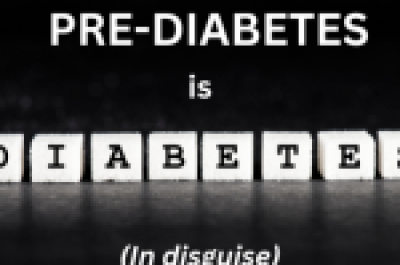Pre-Diabetes is Diabetes in Disguise

Why Waiting for a Diabetes Diagnosis
Puts Your Health at Risk
Many people think pre-diabetes is just a warning sign—something they can ignore until it becomes a bigger problem. But the reality is, pre-diabetes is already diabetes in disguise. By the time a doctor officially diagnoses type 2 diabetes, metabolic damage has been happening for years—sometimes even decades.
The good news? You don’t have to wait for a diagnosis to take control of your health. At Intentional Wellness, Inc., I focus on catching blood sugar imbalances early—before they spiral into full-blown diabetes. If your doctor has ever told you that you’re “borderline” or your blood sugar is “a little high,” that’s your sign to take action now.
What is Pre-Diabetes?
Pre-diabetes means that blood sugar levels are higher than normal, but not high enough for an official diabetes diagnosis. The problem? The damage has already begun.
Most people with pre-diabetes already have:
- Insulin resistance (cells struggling to process blood sugar efficiently)
- Increased inflammation and oxidative stress
- Fatigue, sugar cravings, and blood sugar crashes
- Higher risk of nerve damage, heart disease, and metabolic dysfunction
Doctors diagnose pre-diabetes based on the following markers:
- Fasting blood sugar: 100–125 mg/dL (above 125 = diabetes)
- A1C (3-month blood sugar average): 5.7–6.4% (above 6.4% = diabetes)
- Post-meal glucose: 140–199 mg/dL (above 200 = diabetes)
The issue? By the time these markers are elevated, insulin resistance has already been developing for years.
Why Pre-Diabetes is Actually Early-Stage Diabetes
Your Metabolism Has Already Been Struggling for Years
Insulin resistance starts long before blood sugar reaches “pre-diabetic” levels. The body compensates for poor blood sugar control by producing extra insulin, keeping fasting glucose in range—until it can’t anymore.
If your blood sugar is creeping up every year, it’s not a harmless trend. It’s the beginning of diabetes, even if it hasn’t crossed the official threshold yet.
High Insulin Can Hide the Problem for Years
Most doctors focus only on fasting glucose and A1C, but fasting insulin rises first—often 10-20 years before a diabetes diagnosis. If you’re not testing insulin, you’re missing the early warning signs.
By the time blood sugar levels are high enough to be flagged, the body has already been overproducing insulin for years, leading to stubborn weight gain, energy crashes, and increased inflammation.
Pre-Diabetes Already Increases Disease Risk
Even slightly elevated blood sugar increases the risk of:
- Heart disease (Pre-diabetics are twice as likely to develop cardiovascular disease)
- Nerve damage (Many pre-diabetics already have mild neuropathy)
- Cognitive decline and Alzheimer’s (Now called “type 3 diabetes”)
- Vision problems and early-stage kidney damage
Waiting for full-blown diabetes before taking action means allowing years of silent damage to accumulate.
Why Your Doctor Might Say “Let’s Just Watch It” (and Why That’s a Mistake)
Many doctors take a wait-and-see approach to pre-diabetes, telling patients to “eat better and exercise” but not offering a clear plan. The problem? Pre-diabetes doesn’t just go away on its own.
“Your Blood Sugar is Just a Little High” (But It’s Actually a Big Deal)
If your fasting glucose or A1C is slightly elevated, you might hear, “It’s nothing to worry about yet.” But a slight elevation today can become full diabetes in a few short years if nothing changes.
Standard Treatments Focus on Managing, Not Reversing
Conventional medicine waits until diabetes develops, then prescribes medication to manage it. Functional medicine focuses on reversing insulin resistance before diabetes happens—which is the key to lasting health.
The Functional Medicine Approach to Reversing Pre-Diabetes
Instead of waiting for an official diagnosis, I help clients address the root causes of insulin resistance and blood sugar dysfunction early.
Test More Than Just Fasting Glucose
Instead of relying only on A1C or fasting blood sugar, I recommend checking:
- Fasting insulin (Optimal: Below 5, but many pre-diabetics have levels over 10)
- Post-meal glucose (Should stay below 120 mg/dL after eating)
- C-reactive protein (CRP) (Measures inflammation, which contributes to insulin resistance)
These early warning markers help detect metabolic dysfunction before it becomes diabetes.
Balance Blood Sugar with Smart Eating Strategies
- Reduce processed carbs and added sugars to prevent blood sugar spikes.
- Prioritize protein, fiber, and healthy fats to stabilize glucose levels.
- Use natural blood sugar regulators like cinnamon, berberine, and apple cider vinegar.
Improve Insulin Sensitivity with Lifestyle Changes
- Walk after meals to help muscles absorb glucose without extra insulin.
- Strength training builds muscle, improving blood sugar control naturally.
- Prioritize sleep and manage stress—high cortisol makes insulin resistance worse.
Support Metabolic Health with Key Nutrients
- Magnesium – Helps regulate insulin and blood sugar.
- Omega-3s – Reduce inflammation and improve insulin sensitivity.
- B vitamins – Support mitochondrial energy production and metabolism.
You Shouldn’t Wait for a Diabetes Diagnosis to Take Action
If you’ve been told you have pre-diabetes or “borderline” blood sugar, don’t wait for it to get worse before taking action. Metabolic dysfunction is already happening—and the sooner you address it, the easier it is to reverse.
At Intentional Wellness, Inc., I help clients:
- Identify and reverse the early signs of insulin resistance.
- Develop a personalized plan to stabilize blood sugar and improve metabolic health.
- Prevent full-blown diabetes with nutrition, movement, and lifestyle strategies.
Don’t wait for a formal diagnosis of diabetes—start taking control of your blood sugar today.
Schedule a consultation to get a personalized plan for reversing pre-diabetes now!



